

Compact Muon Solenoid
LHC, CERN
| CMS-PAS-EXO-16-009 | ||
| Search for excited leptons in the $\ell\ell\gamma$ final state at $ \sqrt{s} = $ 13 TeV | ||
| CMS Collaboration | ||
| August 2016 | ||
| Abstract: This note presents a search for a possible compositness of electrons and muons using 2.7 fb$^{-1}$ of proton-proton collisions at a centre-of-mass energy of $ \sqrt{s} = $ 13 TeV collected with the CMS detector in 2015. Excited leptons ($\ell^*$) are assumed to be produced via contact interactions in conjunction with the corresponding standard model lepton. The decays considered here are $\ell^* \to \ell \gamma$ with $\ell = e,\mu$. The number of events observed in data is consistent with background processes from the standard model of particle interactions and exclusion limits on the excited lepton mass, and the compositness scale $\Lambda$, are set. For the case $M_{\ell^*} = \Lambda$, the existence of excited electrons (muons) up to masses of 2.8 (3.0) TeV is excluded. This analysis sets the most stringent limits on $\ell^*$ to date. | ||
| Links: CDS record (PDF) ; inSPIRE record ; CADI line (restricted) ; | ||
| Figures | |

png pdf |
Figure 1:
Feynman diagram for the investigated ${\ell \ell \gamma }$ channels. |
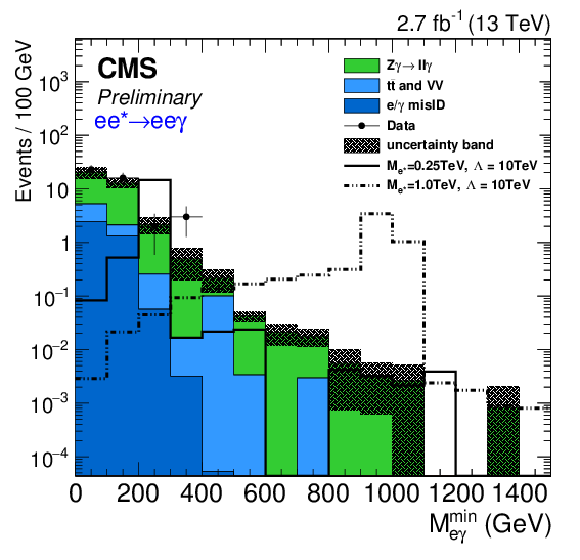
png pdf |
Figure 2-a:
${M_{\ell \gamma }^\text {min}}$ and ${M_{\ell \gamma }^\text {max}}$ for the electron channel in the upper row and the muon channel below. The different background contributions are shown in colors according to the legend. Also shown are two examples of potential ${\ell ^*}$ signals. |
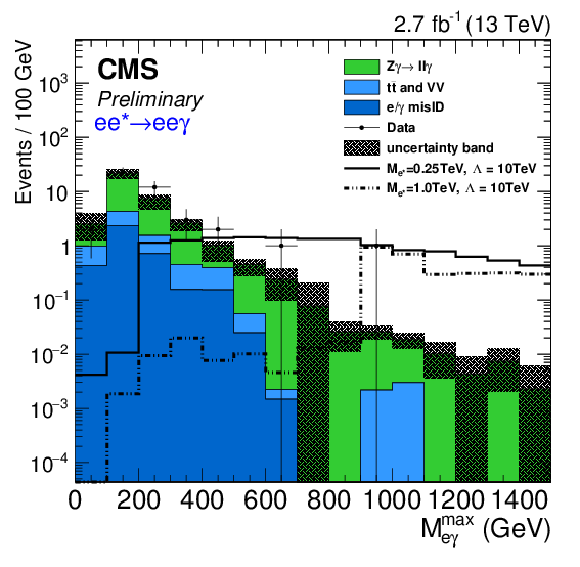
png pdf |
Figure 2-b:
${M_{\ell \gamma }^\text {min}}$ and ${M_{\ell \gamma }^\text {max}}$ for the electron channel in the upper row and the muon channel below. The different background contributions are shown in colors according to the legend. Also shown are two examples of potential ${\ell ^*}$ signals. |

png pdf |
Figure 2-c:
${M_{\ell \gamma }^\text {min}}$ and ${M_{\ell \gamma }^\text {max}}$ for the electron channel in the upper row and the muon channel below. The different background contributions are shown in colors according to the legend. Also shown are two examples of potential ${\ell ^*}$ signals. |
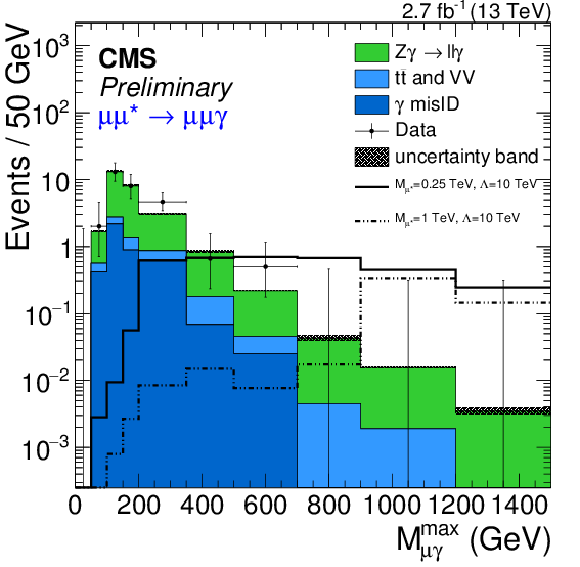
png pdf |
Figure 2-d:
${M_{\ell \gamma }^\text {min}}$ and ${M_{\ell \gamma }^\text {max}}$ for the electron channel in the upper row and the muon channel below. The different background contributions are shown in colors according to the legend. Also shown are two examples of potential ${\ell ^*}$ signals. |
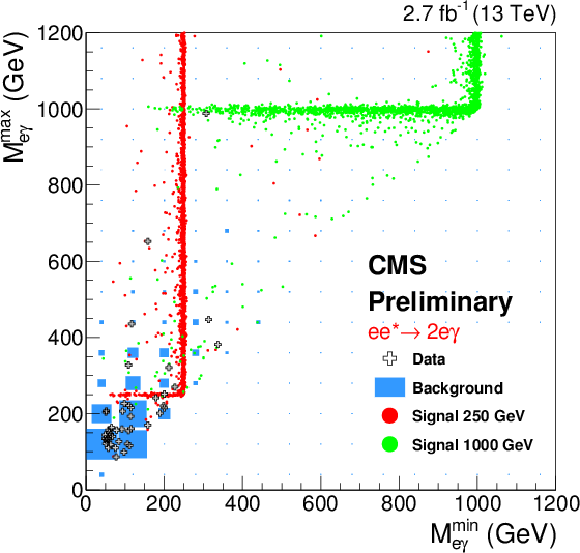
png pdf |
Figure 3-a:
2D ${M_{\ell \gamma }^\text {min}}$ versus ${M_{\ell \gamma }^\text {max}}$ distribution after full selection except the L-shaped search window, with expected background (blue), data (black crosses) and two signal examples for ${\ell ^*}$ masses as given in the legend. The size of the blue squares for the background correspond to the number of events in a particular bin. On the left for the electron channel which has a high detector resolution over the full mass range. On the right for the muon channel where resolution degrades with mass. The background is weighted to the luminosity and the cross section. |
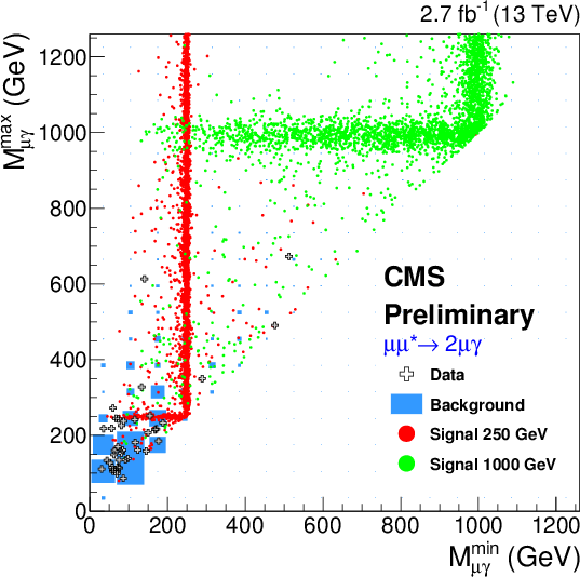
png pdf |
Figure 3-b:
2D ${M_{\ell \gamma }^\text {min}}$ versus ${M_{\ell \gamma }^\text {max}}$ distribution after full selection except the L-shaped search window, with expected background (blue), data (black crosses) and two signal examples for ${\ell ^*}$ masses as given in the legend. The size of the blue squares for the background correspond to the number of events in a particular bin. On the left for the electron channel which has a high detector resolution over the full mass range. On the right for the muon channel where resolution degrades with mass. The background is weighted to the luminosity and the cross section. |

png pdf |
Figure 4-a:
Exclusion limits for electrons (a,b) and muons (c,d). On (a,c) the limit on the product of cross section and branching fraction. On (b,d) the limit on the compositness scale $\Lambda $. |

png pdf |
Figure 4-b:
Exclusion limits for electrons (a,b) and muons (c,d). On (a,c) the limit on the product of cross section and branching fraction. On (b,d) the limit on the compositness scale $\Lambda $. |

png pdf |
Figure 4-c:
Exclusion limits for electrons (a,b) and muons (c,d). On (a,c) the limit on the product of cross section and branching fraction. On (b,d) the limit on the compositness scale $\Lambda $. |
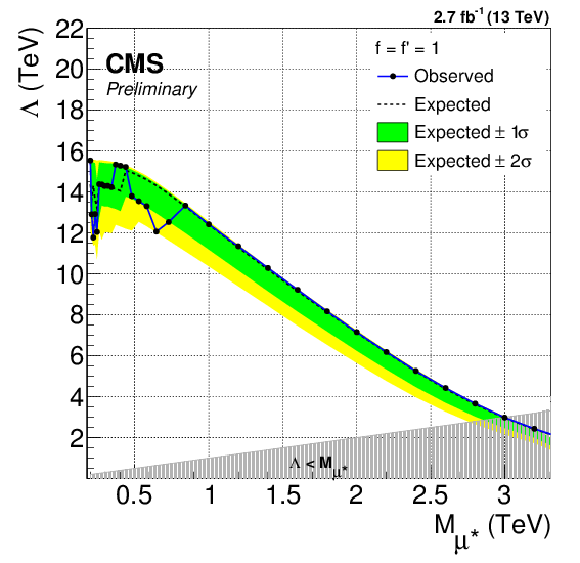
png pdf |
Figure 4-d:
Exclusion limits for electrons (a,b) and muons (c,d). On (a,c) the limit on the product of cross section and branching fraction. On (b,d) the limit on the compositness scale $\Lambda $. |
| Tables | |
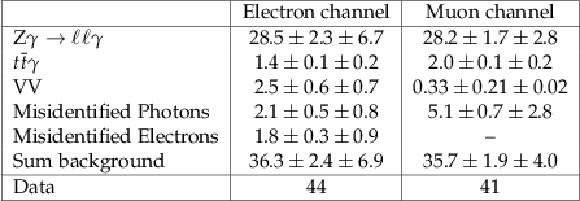
png pdf |
Table 1:
Number of observed events in data compared to expected backgrounds with uncertainties after all selection steps except the L-shaped search window. |
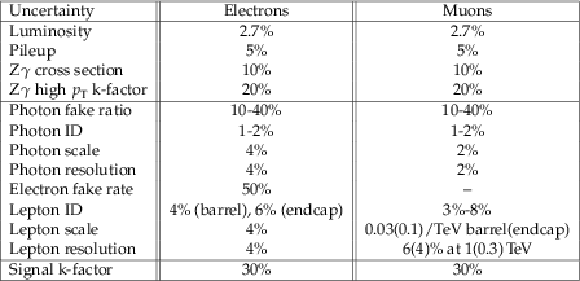
png pdf |
Table 2:
Sources of systematic uncertainties. A range is provided for $\mathrm {p_T} $-dependent uncertainties. |

png pdf |
Table 3:
Summary of the observed (expected) limits on ${\ell ^*}$ mass, assuming ${M_\ell ^*} = \Lambda $. |
| Summary |
| A search for excited leptons in the final state with two high $p_{\mathrm{T}}$ leptons and one photon has been performed using the 2015 data set of 2.7 fb$^{-1}$ at $\sqrt{s} =$ 13 TeV recorded with the CMS detector. Events with a dilepton invariant mass significantly above the Z-pole mass, above 116 GeV, are selected. No significant excess is found and limits on the product of cross section and branching fraction are shown. Limits on the $\ell^{*}$ mass as a function of the compositness scale $\Lambda$ exclude excited leptons below 2.8(3.0) TeV for the electron(muon) channel for $ M_{\ell^{*}} = \Lambda$ and values of $\Lambda$ up to more than 14(15) TeV at low $ M_{\ell^{*}} $. |
| References | ||||
| 1 | J. C. Pati, A. Salam, and J. A. Strathdee | Are quarks composite? | PLB 59 (1975) 265 | |
| 2 | H. Terazawa, M. Yasu\`e, K. Akama, and M. Hayshi | Observable effects of the possible substructure of leptons and quarks | PLB 112 (1982) 387 | |
| 3 | M. Abolins et al. | Testing the Compositeness of Quarks and Leptons | in Elementary Particles and Future Facilities (Snowmass 1982), p. 274 1982eConf C8206282 | |
| 4 | E. Eichten, K. D. Lane, and M. E. Peskin | New Tests for Quark and Lepton Substructure | PRL 50 (1983) 811 | |
| 5 | H. Harari | Composite models for quarks and leptons | Physics Reports 104 (1984) 159 | |
| 6 | K. D. Lane, F. E. Paige, T. Skwarnicki, and W. J. Womersley | Simulations of supercollider physics | PR 278 (1997) 291 | hep-ph/9412280 |
| 7 | U. Baur, M. Spira, and P. M. Zerwas | Excited quark and lepton production at hadron colliders | PRD 42 (1990) 815 | |
| 8 | O. W. Greenberg and C. A. Nelson | Composite Models of Leptons | PRD 10 (1974) 2567 | |
| 9 | O. W. Greenberg and J. Sucher | A quantum structure dynamic model of quarks, leptons, weak vector bosons, and Higgs mesons | PLB 99 (1981) 339 | |
| 10 | CMS Collaboration | Search for excited leptons in $ pp $ collisions at $ \sqrt{s}=7 $ TeV | Phys.Lett. B720 (2013) 309--329 | CMS-EXO-11-034 1210.2422 |
| 11 | CMS Collaboration | Search for excited leptons in proton-proton collisions at sqrt(s) = 8~TeV | JHEP 03 (2016) 125 | CMS-EXO-14-015 1511.01407 |
| 12 | ATLAS Collaboration | Search for excited leptons in proton-proton collisions at $ \sqrt{s} $ = 7~TeV with the ATLAS detector | PRD 85 (2012) 072003 | 1201.3293 |
| 13 | ATLAS Collaboration | Search for excited electrons and muons with 13~fb$ ^{-1} $ of proton--proton collisions at $ \sqrt{s}=8 $ TeV with the ATLAS detector | ATLAS-CONF-2012-146 (Nov, 2012) | |
| 14 | ALEPH Collaboration | Search for excited leptons at 130--140 GeV | PLB 385 (1996) 445 | |
| 15 | DELPHI Collaboration | Search for composite and exotic fermions at LEP 2 | EPJC 8 (1999) 41 | hep-ex/9811005 |
| 16 | OPAL Collaboration | Search for unstable heavy and excited leptons at LEP 2 | EPJC 14 (2000) 73 | hep-ex/0001056 |
| 17 | L3 Collaboration | Search for excited leptons at LEP | PLB 568 (2003) 23 | hep-ex/0306016 |
| 18 | H1 Collaboration | Search for excited electrons in $ ep $ collisions at HERA | PLB 666 (2008) 131 | 0805.4530 |
| 19 | CDF Collaboration | Search for Excited and Exotic Electrons in the $ e\gamma $ Decay Channel in $ \rm {p}\overline{\rm p} $ Collisions at $ \sqrt{s} $ = 1.96 TeV | PRL 94 (2005) 101802 | hep-ex/0410013 |
| 20 | CDF Collaboration | Search for Excited and Exotic Muons in the $ \mu\gamma $ Decay Channel in $ \rm {p}\overline{\rm p} $ Collisions at $ \sqrt{s} $ = 1.96 TeV | PRL 97 (2006) 191802 | hep-ex/0606043 |
| 21 | D0 Collaboration | Search for excited muons in $ {p}\overline{p} $ collisions at $ \sqrt{s} = 1.96 $ TeV | PRD 73 (2006) 111102 | hep-ex/0604040 |
| 22 | D0 Collaboration | Search for excited electrons in $ {p}\overline{p} $ collisions at $ \sqrt{s} = 1.96 $ TeV | PRD 77 (2008) 091102 | 0801.0877 |
| 23 | CMS Collaboration | The CMS experiment at the CERN LHC | JINST 03 (2008) S08004 | CMS-00-001 |
| 24 | CMS Collaboration | CMS Luminosity Measurement for the 2015 Data Taking Period | ||
| 25 | T. Sj\"ostrand, S. Mrenna, and P. Z. Skands | PYTHIA 6.4 physics and manual | JHEP 05 (2006) 026 | hep-ph/0603175 |
| 26 | T. Sj\"ostrand, S. Mrenna, and P. Z. Skands | A brief introduction to PYTHIA 8.1 | CPC 178 (2008) 852 | hep-ph/07103820 |
| 27 | S. Majhi | QCD corrections to excited lepton (pair) production at the LHC | PRD 88 (2013), no. 7, 074028 | 1210.8307 |
| 28 | J. Alwall et al. | The automated computation of tree-level and next-to-leading order differential cross sections, and their matching to parton shower simulations | JHEP 07 (2014) 079 | 1405.0301 |
| 29 | P. Nason | A New method for combining NLO QCD with shower Monte Carlo algorithms | JHEP 0411 (2004) 040 | hep-ph/0409146 |
| 30 | S. Frixione, P. Nason, and C. Oleari | Matching NLO QCD computations with Parton Shower simulations: the POWHEG method | JHEP 0711 (2007) 070 | 0709.2092 |
| 31 | S. Alioli, P. Nason, C. Oleari, and E. Re | A general framework for implementing NLO calculations in shower Monte Carlo programs: the POWHEG BOX | JHEP 1006 (2010) 043 | 1002.2581 |
| 32 | CMS Collaboration | Performance of Electron Reconstruction and Selection with the CMS Detector in Proton-Proton Collisions at √s = 8 TeV | JINST 10 (2015), no. 06, P06005 | CMS-EGM-13-001 1502.02701 |
| 33 | CMS Collaboration | Search for a Narrow Resonance Produced in 13$ TeV $ pp Collisions Decaying to Electron Pair or Muon Pair Final States | ||
| 34 | CMS Collaboration | Electron and Photon performance using data collected by CMS at $ \sqrt{s} $ = 13~TeV and 25~ns | CDS | |
| 35 | CMS Collaboration | Performance of Photon Reconstruction and Identification with the CMS Detector in Proton-Proton Collisions at sqrt(s) = 8 TeV | JINST 10 (2015), no. 08, P08010 | CMS-EGM-14-001 1502.02702 |
| 36 | J. Butterworth et al. | PDF4LHC recommendations for LHC Run II | JPG43 (2016) 023001 | 1510.03865 |
| 37 | J. Gao and P. Nadolsky | A meta-analysis of parton distribution functions | JHEP 07 (2014) 035 | 1401.0013 |
| 38 | S. Carrazza et al. | An Unbiased Hessian Representation for Monte Carlo PDFs | EPJC75 (2015), no. 8, 369 | 1505.06736 |
| 39 | G. Watt and R. S. Thorne | Study of Monte Carlo approach to experimental uncertainty propagation with MSTW 2008 PDFs | JHEP 08 (2012) 052 | 1205.4024 |
| 40 | NNPDF Collaboration | Parton distributions for the LHC Run II | JHEP 04 (2015) 040 | 1410.8849 |
| 41 | ATLAS and CMS Collaborations | Procedure for the LHC Higgs boson search combination in Summer 2011 | CMS-NOTE-2011-005 | |
| 42 | J. Heinrich et al. | interval estimation in the presence of nuisance parameters. 1. Bayesian approach | physics/0409129 | |

|
Compact Muon Solenoid LHC, CERN |

|

|

|

|

|

|